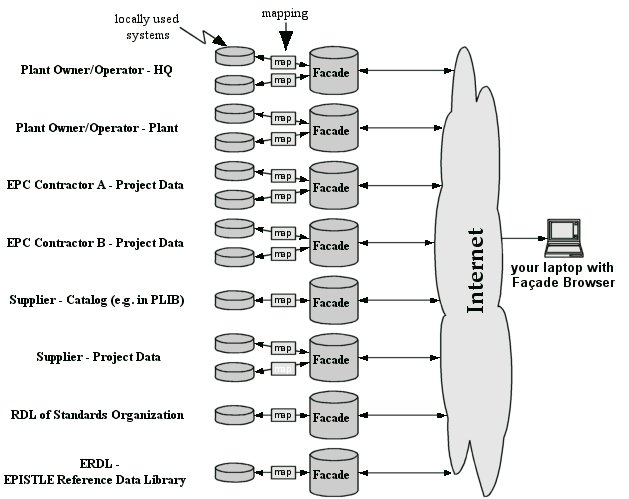During a plant’s lifetime, many stakeholders deploy a variety of software tools to create and use plant data. These programs store data in their own, proprietary, formats, making information exchange difficult and costly.
ISO 15926-2
Since the late eighties, an international team has developed a data model to cover the whole lifecycle of plant business objects, now standardized as ISO 15926-2. Such generic data models require reference data libraries to specify the exact information content. ISO 15926-4 contains such a library for industrial components, with clear definitions of all the terms used. ISO 15926-7 extends these to support internet-based data exchange through XML documents.
Templates
These XML documents can be transformed to more commonly used document formats. The data model is transformed to ‘Atomic Templates’ in an XML Schema. These are used to build ‘Molecular Templates’ which include rules (e.g. for referential integrity). Molecular Templates are then used to define Object Information Models (OIM). The OIM allows users to map data elements in their own computer systems in a manner that defines the information content of their document types. Different documents use different views of the same, standard, OIM. Once these preparations have been completed, the user can start producing XML files for information integration, exchange, and transfer.
Facades
ISO 15926-7 defines a ‘Facade,’ a web data base that stores all exchanged XML files, resulting in full ‘4D information integration.’ 4D means that the information is recorded in both space and time. A Facade can reproduce the state of an object at any time in the past, present, and planned future. A Facade only stores the information produced by the owner of that Facade. Related information, owned by others, is automatically retrieved from Facades, via the Internet—reducing data duplication.
Peer to peer
Facades operate on a peer-to-peer basis. With a Facade Browser one can read the information of a set of Facades as if it were stored on one’s own Facade. The chain of Facades starts at a small System Facade for each application program. Data from each application is mapped to and stored in its own Facade. From there on, data exchanges between Facades follow a standard pattern. The use of a web-based Facade Browser transforms information from the XML document to a presentable format, making different systems appear compliant from the Internet. Facades support publishing, exchange and transfer of data. The owner of the information transfers custody for that information, and physically transfers the records to another Facade. This is what happens upon hand-over, say from Engineering Prime Contractor (EPC) to Plant Owner/Operator.
How much?
The access to the Reference Data Library, as well as the software for the Document Template Builder, the Mapper, the Facade, and the Facade Browser will available to all free of charge. The software industry is invited to leverage these tools to develop enhanced systems with more functionality. The next step is to execute an Open Source project where the ISO/XML standard is implemented and tested on pilot projects. More from www.infowebml.ws.

© Oil IT Journal - all rights reserved.